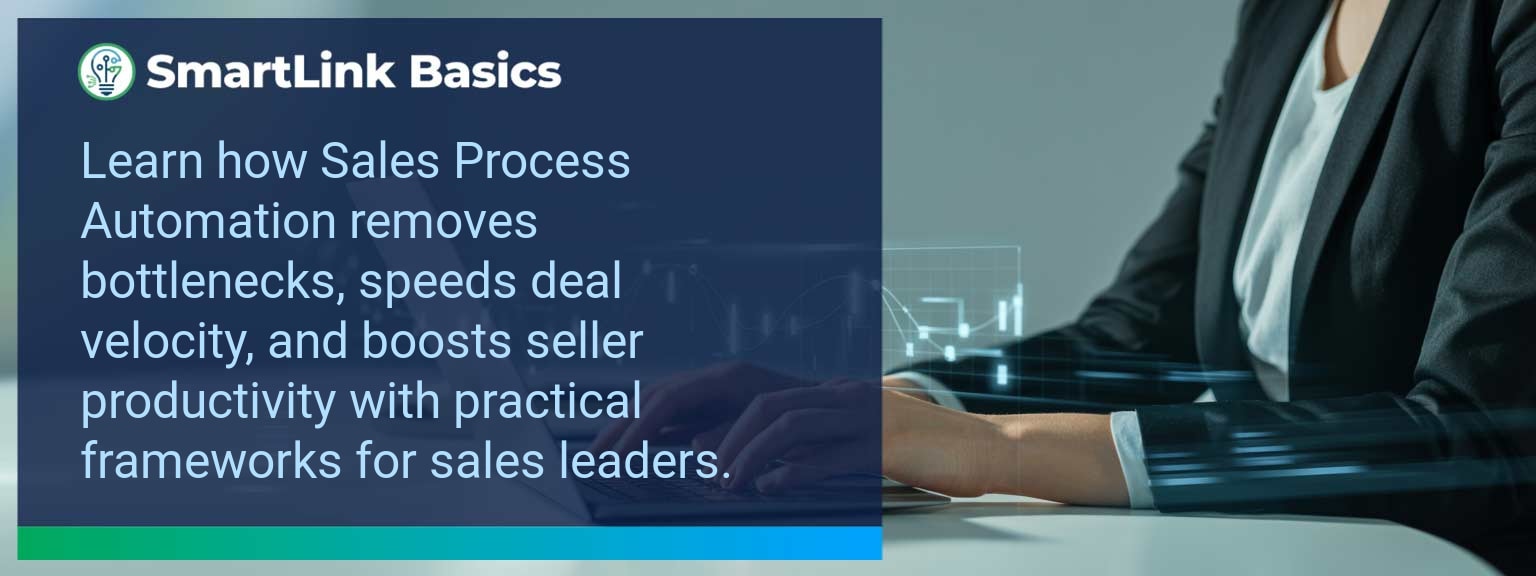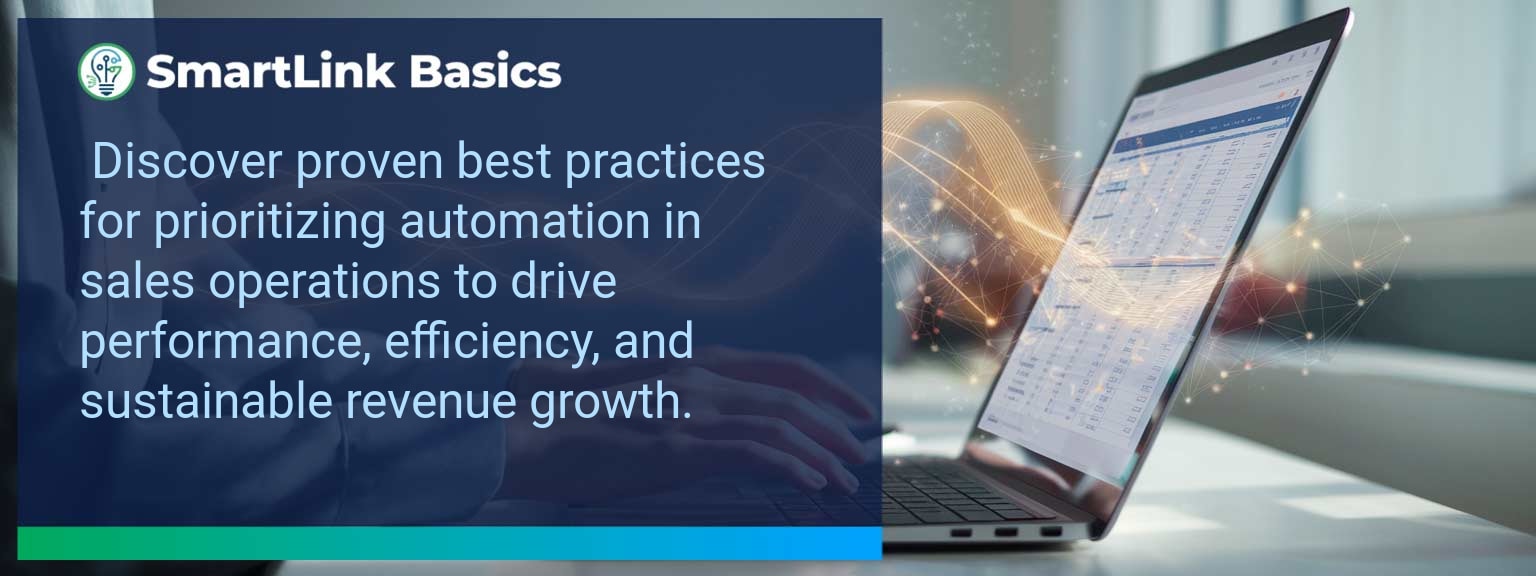Average B2B reps spend 40% of their week on administrative tasks. At SmartLink Basics, we see how Sales Process Automation immediately frees sellers to focus on revenue-generating work. This post shows which bottlenecks are tripping up pipelines, which automation levers to pull, and a pragmatic 90-day plan you can use. Read on to get frameworks, examples, and metrics to measure change.
- Sales Process Automation removes manual handoffs, speeds follow-up, and reduces errors.
- Design an operating system: ICP, pipeline architecture, plays, and cadence.
- Use sales automation tools and CRM workflow automation to integrate marketing and service flows.
- Enable lead qualification automation and AI lead scoring to prioritize outreach.
- Track leading, lagging, and quality metrics to continuously improve.
What Changed and Why Sales Process Automation Matters Now
Buyers respond faster to timely outreach. Sales teams that fail to follow up within 24 hours lose momentum. Sales Process Automation turns manual delays into predictable, measurable steps that increase sales velocity. Use automation to enforce the sales cadence, keep CRM data hygiene, and route leads to the right rep.
Automation also standardizes repeatable plays. This reduces variance between sellers and gives leaders clear levers to scale performance. For teams facing revenue pressure, automation is the difference between reactive work and planned outcomes.
Redesign the Revenue Operating System with Sales Process Automation
Don’t bolt tools onto a broken workflow. Redesign the operating system to match how buyers move. That alignment makes CRM workflow automation and workflow integration effective rather than noisy.
Below are the four core elements to redesign. Each element maps to specific automation actions and enablement priorities.
ICP, Segmentation, and Targeting
Define the ideal customer profile and segment by value and effort. Automation helps tag and route leads based on firmographic and behavioral signals. For example, assign high-value accounts to senior reps automatically and enroll lower-touch segments into nurture cadences.
Actionable insight: build segment-based playbooks and automate enrollment so reps see only relevant opportunities.
Pipeline Architecture
Map stages to clear milestones and handoff rules. Use CRM workflow automation to move deals when conditions are met rather than relying on manual updates. This keeps forecasts accurate and prevents stalls at stage gates.
Actionable insight: add automated reminders and conditional stage exits to eliminate stalled deals.
Plays and Messaging
Document repeatable plays and automate the triggers. Sales automation tools can push content, templates, and next-step tasks into a rep’s queue based on stage and intent signals. This preserves messaging consistency and shortens time-to-proposal.
Actionable insight: implement content libraries with automated suggestions tied to playbooks.
Operating Cadence
Set a weekly rhythm of reviews, coaching, and pipeline hygiene. Automate status reports and exception alerts so leaders spend time coaching, not compiling reports. A disciplined cadence makes process gains repeatable.
Actionable insight: schedule automated scorecard updates and exceptions for any deal older than X days in a stage.
How Sales Process Automation Removes Bottlenecks
Automation eliminates manual steps that create queueing and human error. For example, automated lead routing prevents ownership confusion and reduces lead follow-up time. That single change often raises conversion rates in early funnel stages.
Example: a mid-market SaaS firm used CRM workflow automation to route trials and reduced lead response time from 48 hours to under two hours. Action: start with the highest-volume handoff and automate that flow first.
Enhancing Lead Qualification with Automation
Lead qualification automation combines firmographic rules with AI lead scoring and behavioral signals. This creates a prioritized list of contacts for sales outreach. Lead scoring improves efficiency because reps contact the leads most likely to convert.
Example: pair lead scoring with lead qualification automation so low-intent leads enter nurture and high-intent leads trigger a sales cadence. Actionable step: test an AI scoring model on a single segment for four weeks.
Integrating Systems for Seamless Communication
Integration prevents information silos. Connect marketing automation, CRM, and customer service so lead data flows and context travel with the account. Workflow integration prevents duplicate work and improves handoffs.
Example: an automated notification for support escalations routed to account owners reduced churn risk and improved renewal outcomes. Action: map key data fields and automate updates across systems.
Leveraging Analytics to Drive Continuous Improvement
Automation collects the signals you need to improve. Use sales analytics to identify stage drop-off, time-in-stage, and response time trends. Dashboards make bottlenecks visible so leaders can prioritize interventions.
Example: a dashboard showing time-to-first-contact by source exposed a marketing channel that required dedicated SDR coverage. Actionable insight: build a rolling dashboard and review it weekly with the operating cadence.
Training Sales Teams to Embrace Automation
Adoption fails when training is vague. Train reps on the “why” and the “how.” Use role-based sessions that focus on real tasks, not features. Track CRM activity changes and coach against behavioral targets.
Example: a phased rollout with shadowing and scorecard incentives increased platform adoption to 85% within 60 days. Action: assign automation champions to support frontline teams.
The table below lists the key performance metrics to track when implementing automation. Use these measures to align behaviors, outcomes, and perceived quality.
| Category | Metric | Definition | Target |
|---|---|---|---|
| Leading | Average Time to First Contact | Median minutes from lead creation to first outreach | < 120 minutes |
| Leading | Automated Play Enrollment Rate | % of qualified leads auto-enrolled into playbooks | 95%+ |
| Lagging | Weekly Pipeline Velocity | Value progression through stages per week | 10%+ increase in 90 days |
| Lagging | Win Rate by Segment | Closed-won % of opportunities by segment | Improve 3–5 pts |
| Quality | CRM Data Hygiene Score | % of records meeting completeness and accuracy rules | 90%+ |
| Quality | Play Adoption and Satisfaction | % of reps using plays and average satisfaction rating | 80% adoption; 4/5 satisfaction |
Get the 90-day plan, coaching rubric, and dashboard template to operationalize AI in your enablement program.
Results From Sales Process Automation
Teams that implement these changes see faster response times, cleaner CRM data, and higher conversion rates. Sales automation tools and CRM workflow automation close common gaps between marketing and sales. For leaders, the payoff is predictable pipeline and scalable coaching signals.
Example: a regional firm improved lead-to-opportunity conversion 18% in 90 days by combining lead scoring, automated routing, and a simplified playbook. Action: measure, iterate, and expand automation in controlled pilots.
Scaling Teams With Automation And AI
Scaling requires standard processes, reliable data, and repeatable coaching. Use sales analytics to find where automation unlocks the most seller time. Then scale the highest-impact automations across segments.
Implementing AI lead scoring and lead qualification automation on a single product line lets you validate models before broad rollouts. Action: run a 12-week validation with a control group and measure influence on win rate and sales cadence adherence.
Make Automation Your Revenue Multiplier With Measured Steps
Start with one segment, automate the highest-friction handoff, and measure the impact on response time and conversion. The steps above compress sales cycles, improve CRM data hygiene, and deliver clearer coaching signals. Take the 90-day plan, run a controlled pilot, and scale the wins using AI-driven sales enablement resources from SmartLink Basics.








